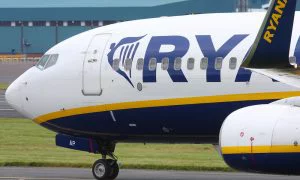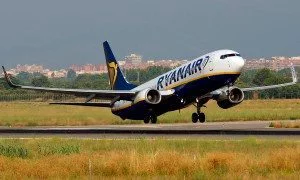Share Tweet Share Share Email Comments
Ryanair today reported a 4% rise in Q1 profit to €256m, as traffic grew 11% to 31m while average fare fell 10% to €39.92, offset by a 9% reduction in unit costs.
Ryanair’s Michael O’Leary said:
“This modest 4% increase in Q1 profit to €256m is in line with previous guidance. The absence of Easter in Q1 and on-going market volatility arising from terrorist events, and repeated ATC strikes (particularly in France) weakened fares on close-in bookings and caused almost 1,000 flight cancellations. We remain committed to our load factor active/yield passive strategy which is why Q1 fares fell 10% to under €40. Traffic rose 11% and load factor improved 2 points to 94% as our Always Getting Better (“AGB”) customer experience programme continues to win new customers and new markets. Ancillary sales rose to 26% of revenues (24% in PY Q1). Cost control remains core which is why unit costs reduced 9% (ex-fuel down 4%).
Highlights of Q1 include:
- Average fares cut 10% to €39.92
- Traffic up 11% to 31m (LF up 2% to 94%)
- Unit costs down 9% (ex-fuel -4%)
- Profits up 4% to €256m
- 16 new B737-800’s delivered
- Share buyback programme (€886m) completed in June
New Routes and Bases:
The airline’s four new S16 bases in Belfast, Corfu, Ibiza and Santiago are performing well with strong advance bookings. Ryanair announced eight new bases (Bucharest, Bournemouth, Hamburg, Nuremburg, Prague, Sofia, Timișoara and Vilnius) as part of its W16 schedule which will also see its Berlin base grow from four to nine aircraft and Luxembourg become its 33rd country.
Ryanair will launch 133 new routes during W16.
“Sadly, the introduction of an NOK80 (€8.50) air travel tax in Norway has led to 16 route cancellations and the closure of our Oslo Rygge base in October”, the airline said.
Lower Costs
Ryanair’s cost advantage over competitors increased in Q1 as unit costs fell 9%. Fuel fell by €42m to €518m in Q1. Ex-fuel unit costs were cut 4% due to lower cost aircraft, cheaper financing, discounted airport growth deals, lower sales & marketing spend, and weaker sterling, which was partly offset by slightly higher staff costs as 5 year pay deals kick in across its 84 bases and its headcount rises in line with fleet growth.
FY17 fuel is 95% hedged at $622 per tonne (c. $62bbl) which will (allowing for additional volumes) deliver fuel savings of c. €200m. Almost 55% of Ryanair’s FY18 fuel is now hedged at just under $500 per tonne (c. $50bbl).
Brexit
The recent UK vote to leave the European Union was both a surprise and a disappointment to Ryanair.
“Ryanair, as the UK’s largest airline, had campaigned actively for a “Remain” vote. We expect this result will lead to a considerable period of political and economic uncertainty in both the UK and the EU. This uncertainty will be damaging to economic growth and consumer confidence and we will respond as always with our load factor active/yield passive strategy. Until some clarity emerges over the next two years about the UK’s long term political and economic relationships with the EU, we will be unable to predict what effect it will have on our business and regulatory environment, but we have contingency plans in place for all eventualities”, the airline said in a statement.
“In the near term we expect that Brexit uncertainty will lead to weaker sterling, slower growth in the UK and EU economies and downward pressure on fares until the end of 2017 at least. Over the longer term, if the UK is unable to negotiate access to the single market/open skies it may have implications for our 3 UK domestic routes and UK nationals on our share register but these risks are not material and will be manageable. There may also be some opportunities if our UK registered competitors are no longer permitted to operate intra EU routes, or must divest their majority ownership of EU registered airlines”, the statement added.
In the meantime, Ryanair will pivot its growth away from UK airports and focus more on growing at our EU airports over the next two years. This winter the Irish airline will cut capacity and frequency on many London Stansted routes, although no routes will close.
Related Items:Ryanair Share Tweet Share Share Email
Recommended for you
-

 EU Extends In-depth Investigation into Alleged State Aid to Ryanair
EU Extends In-depth Investigation into Alleged State Aid to Ryanair -

 Ryanair Slows 2020 Growth and Closes Two Bases
Ryanair Slows 2020 Growth and Closes Two Bases -

 More Instability Ahead in Ryanair Employment Relations, ECA says
More Instability Ahead in Ryanair Employment Relations, ECA says
Click to comment
Leave a Reply
Your email address will not be published. Required fields are marked *
Comment
Email *
Website
Yes, add me to your mailing list
